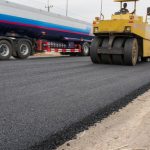What Types of Paint Should I Use on Asphalt Surfaces?
Asphalt surfaces contain a mixture of aggregates, binder, filler, chemicals, and petroleum-based products. Examples include roads, pavements, parking, railway tracks, ports, airway runways, bicycle lanes, and sports arenas.
Asphalt can look pretty dull without paint because the asphalt surface layer is prone to flaking when exposed to the natural environment, such as rain. As much as asphalt is sturdy, that does not make it immune to cracks. Additionally, the composition of asphalt makes it difficult for paint to adhere to it.
Paints I Can Use on Asphalt Surfaces
Let’s look at various types of paint that can make your surfaces shiny and better. Knowing the right paint will ensure structural value and long-lasting results.
100 Percent Acrylic Paint
Special acrylic paint is purposely formulated to adhere to asphalt surfaces, hence being preferred by many professionals.
It is usually polymer-based and is water-soluble, meaning it does not cause damage to the asphalt subgrade and surrounding areas.
It prevents lines from lifting off of the asphalt surface. As a result, they dry very rapidly, meaning projects are completion is faster.
It is durable and can last up to 20 years, subject to various factors. Such as the climate and maintenance levels.
Coal Tar Paint
If you’re asking yourself, "What paint can I use on a resurfaced driveway?" coal tar paint is the best. It is a thick black goop applied on asphalt surfaces subjected to extremely harsh weather conditions. It is a mixture of polymers that makes it tougher and more durable.
Refined coal tar is manufactured for seal coating asphalt surfaces. After a few years, the coal tar should be applied to protect and brighten up the surfaces. It usually adds a rich black coat.
They are mainly preferred because it’s more cost-effective than other types of paint. Additionally, it has excellent water resistance, such that if water or gasoline leaks, it will penetrate down the pavement.
It also has an excellent cathodic disbondment, and a high film builds with just one coat. It can also handle high traffic areas and UV rays. However, its seal coat contains high toxicity that may cause environmental harm and cancer. Due to these effects, some parts of the world have banned its use, such as Austin, Texas.
Oil-Based Paint
The key ingredient to these paints is oil. They are usually used in climates that reach freezing temperatures because they do not freeze.
Oil-based paints are widely applicable because they offer the best durability at competitive prices. One of its main advantages is that it can withstand high-traffic areas for longer times.
Oil paints dry up slowly. They are also not as flexible; hence, they eventually crack and break apart, prompting consumers to replace them.
Water-Based Latex Paint
It’s the cheapest type of paint in the market since water is the primary ingredient. In addition, it has a wide variety of colors to choose from. It dries very fast within hours and is considered environmentally friendly. They also have better color retention compared to solvent paints.
Thermoplastic Paint
Thermoplastic paint has plastics, making it more durable than other paints. As a result, it is ideal for asphalt surfaces because of its durability and stripping done less frequently. One disadvantage is the cost, and it’s usually very expensive.
Reflective Paint
Reflective paint is also known as retro-reflective paint. One key ingredient of this paint is glass beads, making the asphalt surfaces very reflective at night.
It is mainly used for stripping roads and informational road markings. It lasts 15-20 years before needing recoating.
Take Away
Now you have a variety of paints to choose from for your asphalt painting. It is always advisable to consult a specialist before embarking on any asphalt painting job.
More...
Categorised in: Asphalt Driveway




